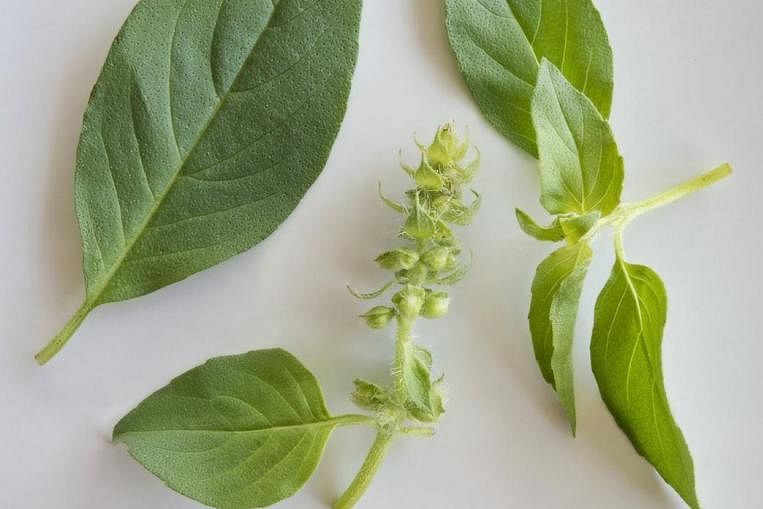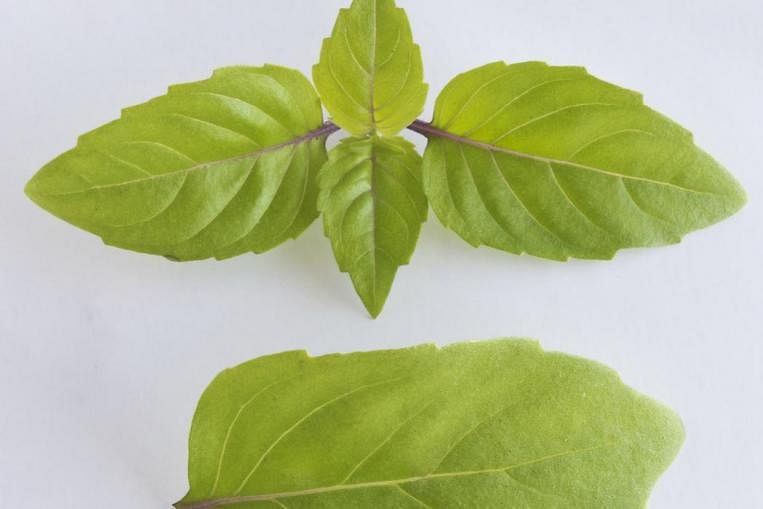
Western sweet basil: Also dubbed Mediterranean basil for its popularity across that region. It is most famously used in Italian pesto and as a frequent sidekick for tomatoes and olive oil in various dishes. Many cultivars with different leaf sizes and shapes exist. Shown here is the type most commonly sold here, with fleshy stems and soft, slightly cup-shaped green leaves that can reach 10 to 12cm in length. It has a sweet, almost floral aroma with distinct clove notes. Its aroma changes and is attenuated in the dried herb, becoming more hay-like and less sweet. Fresh sweet basil can be blended into a paste with some oil and frozen in an airtight container for storage.

Thai sweet basil: Called bai horapa in Thai, this has purple stems, green leaves and dark purple flower spikes. It has strong anise and liquorice notes and, when cooked, is more spicy and forward than Western sweet basil. Add to stir-fries, curries, soups and stews right at the end of cooking. It releases its fragrance as it wilts in the heat. In Thailand, it is also eaten raw as part of a vegetable platter served with nam prik relishes. In Taiwan and China, a basil cultivar with a similar aroma profile is used in recipes such as san bei ji (three cup chicken) and also in Hakka dishes such as lei cha, pestle-pounded mixed herb tea.


Holy basil: Called bai krapao in Thai, this is sharp and peppery - hot to the taste when very fresh. Its piercing aroma, which intensifies when the herb is heated or very lightly cooked, has subtle camphor and allspice notes. Thai groceries may sell two types. The purple type (above) has dark purple stems and purple-flushed green leaves and is a bit stronger in character. It is a good partner for meats and chilli-hot dishes. The "white" type (below) has green leaves on pale green and pale purple stems, and its slightly milder nature suits white meats and seafood. Called tulsi in Hindi, holy basil has few if any culinary applications in India, but is used for devotional purposes and in traditional Ayurvedic medicine.


Lemon basil: Shown here are two types. One is a Western variety (above) with wide, pale green leaves and zesty lemon accents layered atop sweet basil's clove scent. The other is Thai lemon basil (below), called bai maenglak in Thailand and daun kemangi in Malaysia and Indonesia. It has slightly slimmer and darker green leaves, soft and faintly fuzzy stems, and a gentle but pervasive scent hinting at lemongrass, lemon and lime. Both kinds complement seafood, mild curries and soups very well and should be very lightly cooked, if at all.

Cinnamon basil: Bearing serrated-edged green leaves on reddish-purple-tinged stems, this plant has a heady cinnamon character besides a sweet basil aroma profile. Its unique fragrance makes it amenable to savoury dishes, such as stews, braises, soups and salads, as well as sweet dishes, such as fruit compotes and salads, ice cream and sauces. Try it in fruity beverages such as sangria or a Pimms Cup.

Purple basil: Several cultivars exist around the world, differing in leaf shapes and shades. Shown here is one with serrated-edged, teardrop-shaped leaves with a purple-green top and grape-purple underside. Purple basil has an assertive sweet basil aroma. Infuse it in white vinegar to obtain a fragrant, purple-tinted condiment.
Storing basil: Lemon basil and holy basil are fragile and wilt soon after picking, especially in warm conditions, so use them as soon as possible. Swaddle the other types in paper towels, place in plastic bags, gently press out all the air, seal and store in the fridge vegetable drawer for a couple of days. Supermarket potted basil will last for several days if kept well watered, but re-pot it with more compost to keep it going for longer.
Text and photos: Chris Tan
